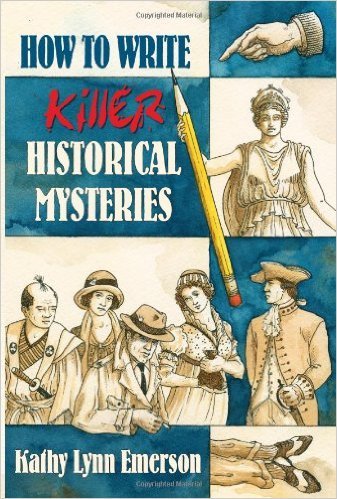Eleanor Sullivan's Blog, page 2
September 8, 2016
Ellery Queen Mystery Magazine
“She Did It Her Way,” was recently published in Ellery Queen Mystery Magazine. In “She Did It Her Way” you’ll hear about EQMM’s second editor, Eleanor Regis Sullivan, from an author who coincidentally shares her name, Eleanor J. Sullivan. Eleanor has previously been published in Mystery Scene Magazine, among others.
The post Ellery Queen Mystery Magazine appeared first on EleanorSullivan.com.
Bicentennial celebration in Zoar, Ohio during 2017
Two exciting events will occur during the Bicentennial celebration in Zoar, Ohio during 2017: My play, “The Case of Goesele v. Bimeler,” will be presented October 6th. Based on a real-life trial brought by an evicted Separatist who sued the village leader, demanding a share of the Society’s property. If he prevails, the Society’s [...]
The post Bicentennial celebration in Zoar, Ohio during 2017 appeared first on EleanorSullivan.com.
September 2, 2016
My Complete Book List on Amazon
Nursing Books Novels Monika Mysteries Recent Releases
The post My Complete Book List on Amazon appeared first on EleanorSullivan.com.
September 1, 2016
Book list
The Accuracy of Historical Novels: Fact or Fiction?
 If you want to research this subject further I have to recommend Kathy Lynn Emerson book
If you want to research this subject further I have to recommend Kathy Lynn Emerson book
How to Write Killer Historical Mysteries: The Art and Adventure of Sleuthing Through the Past
The core of the book is Emerson’s personal take on writing and selling historical mysteries, but it also includes contributions from over forty other historical mystery writers —practical advice, anecdotes, and suggestions for research—and input from assorted editors, booksellers, and reviewers. For both historical mystery writers and readers.
From Booklist
Emerson, author of the Lady Appleton and Diana Spaulding mystery series, turns her hand to how it’s done in this useful guide to writing historical crime fiction. Drawing on her own works and those of her fellow historical-mystery writers (Kerry Greenwood, Alan Gordon, Carola Dunn, and others), she lays out, in commonsense sequence, the stages of planning and writing a historical mystery. Chapters on choosing setting and character, research, crafting a plot, and selling your book offer much of the same information as similar chapters in other how-to books for mystery writers, but the information is nicely tailored for this particular genre. Published writers probably won’t find much here that they don’t already know, but budding historical novelists will discover a wealth of helpful tips and may want to keep a notebook handy to jot them down. The book finds its niche and fills it well. –David Pitt
The post The Accuracy of Historical Novels: Fact or Fiction? appeared first on EleanorSullivan.com.
May 6, 2016
The Writing Life
If you had been with me at the Kansas City library in April, 1994, you would have heard award-winning author, Nancy Pickard, say, “The writing life has little to do with being published.”
“The writing life has little to do with being published.”
What? I thought that was the purpose of writing.
First, she said, you must decide that you want the writing life and, if you do, you must make a commitment to it. You must set aside other activities because the writing life is a strict task master. Writing is not a hobby, something you do on an empty Sunday afternoon. It’s a job like any other. It may be a part-time job, but it’s a job nonetheless.
Decide what time works for you, and make a commitment to write then. Multi-published author friend, Eileen Dreyer, writes from midnight to 4 am. I, on the other hand, write from 9 am till noon.
I made a decision that day in the Kansas City library that I wanted the writing life. One year later I quit my administrative job at the University of Kansas. Then, sandwiched between teaching and professional responsibilities, I wrote my first mystery.
It was terrible.
In her book, Seven Steps on the Writer’s Path, Nancy says that writing is like becoming pregnant and raising children—if women knew what was ahead, it might be the end of civilization.
So I persevered. At last, my first book was published. Now I’m finishing my sixth, Tree of Heaven, due out next year.
The writing life is a way of looking at the world, of noticing, of listening. Gradually shifting from doing to being. Becoming a participant observer. Observing life both from a distance and close up. Keeping a part of you standing aside, noticing others’ reactions and your own responses.
Writing allows you to relive events in your life and make them turn out the way you want. Use you own experiences as fodder—both the good and the bad. If you’re a writer, no experience is lost.
Writing is a privilege. To be able to write, to tell stories that others enjoy, to allow yourself to be creative is a gift you’ve given yourself. Keep learning—about your craft, about the world and the people in it.
The best part of all?
You’re never without something to think about!
The post The Writing Life appeared first on EleanorSullivan.com.
August 1, 2014
Step 10: Fit in the Final Piece: The Resolution
 Almost done. Only one more piece to fit into your puzzle of a story: The Resolution. Time to give your readers some breathing room after the chase of the climax. Keep it brief, however. They’ve read the story, road the emotional roller coaster of emotions–fear, anger, love, relief, and more.
Almost done. Only one more piece to fit into your puzzle of a story: The Resolution. Time to give your readers some breathing room after the chase of the climax. Keep it brief, however. They’ve read the story, road the emotional roller coaster of emotions–fear, anger, love, relief, and more.
Now is the time to tie off loose ends…or not. Some authors make certain that every problem has been resolved, that the characters’ lives are now settled once and for all. I don’t subscribe to that axiom. I want readers to have a sense that my characters will go on living their lives, that they’ll work and live and dream on. Besides, if you write series mysteries, you’ll want your readers to believe that the characters that they’ve learned to love will soon be thrust into another mystery. And they can’t wait to see what they are up to!
On the other hand, too many loose ends and you’ll frustrate your readers. They don’t want to wonder what happened in every area of your characters’ lives. Just like real life, some things are settled now, but others take longer. Let them use their imaginations to ponder what might happen next. Then they’ll be ready to jump into your next book!
Crafting the Last Lines
Like the first line in your book, take some time to craft the closing lines. You want it to linger in your reader’s minds long after she’s closed the book. The closing lines sums up the story, says goodbye, and promises that the story isn’t over.
Here are two of my closing lines:
From Cover Her Body
“She ran her hands over the boulder. This spot, so long her refuge, was only a place, a place where she had been able to draw into herself. She thought she needed to be here to find illumination or consolation. But she had learned that it wasn’t the place, but her own thoughts that soothed her, that made clear what she needed to do. The power wasn’t at this place, or anywhere else, for that matter; it was inside her. And she could reach within whenever she needed to. She fingered a tiny green sprout that had broken through the jagged edge of the tree stump, and turned toward home. ”
From Graven Images
“She folded her hands and raised them to her lips, her heart filled almost to bursting. Benjamin. Her husband. He’d learned from her example. No woman was so humbled as she was at this moment. She stood. “Come,” she said and pulled him from his chair. Tears stood unshed in his eyes, uncertainty plain upon his face. Smiling up at him, she placed his arms around her waist. “I have something to tell you.”
All set now to write your mystery? I wish you my very best!
July 1, 2014
Step 9: Create Final Scenes
 You learned last week that your sleuth has failed. A suspect has been arrested for the murder, and she knows he didn’t do it. She is crushed. Just when all seems hopeless, your sleuth picks herself up again. This time it will be all or nothing. She will push herself to the limit to solve the murder.
You learned last week that your sleuth has failed. A suspect has been arrested for the murder, and she knows he didn’t do it. She is crushed. Just when all seems hopeless, your sleuth picks herself up again. This time it will be all or nothing. She will push herself to the limit to solve the murder.
Now it’s time to pick up the pace. She’s either settled her family problems or someone else will have to take care of them. If they fire her from her job, so be it. She has only one goal: to catch a killer. All else falls by the wayside.
Backed into a wall, she reaches deep inside herself to strength she didn’t know she had to use every ounce of emotional and physical strength she can muster. She is becoming a new and better version of herself, one able to leap tall buildings…uh, not quite that…but close.
If you’ve prepared her with previous tests and you’ve foreshadowed events to come, the ending should reveal itself as inevitable but surprising. All the pieces of the puzzle come together in the final scenes, called the climax.
Climax
Rushing toward the climax, your sleuth thinks of nothing else but catching the killer. Nothing stops her. My sleuth was locked in a burning building in Cover Her Body, but still she escaped to follow the killer’s trail. I’ve had my sleuths attacked from behind with crippling injuries, chased down on foot by a car in a parking garage, and battered by a killer wielding a bat. Each and every time, she picked herself up and went at him again. I can’t wait for Adelaide to face the killer in Tree of Heaven, my work in progress!
Once he’s caught (spoiler alert: she catches him) and dies or is carted off to prison, time to wrap up any loose ends. Do it quickly. Readers don’t want to linger long after all the excitement. Leave them hungry for more!
What’s left to tell about writing a mystery in 10 (easy?) steps? You’ll see in next week’s final step.
May 19, 2014
Step 8: Write Act II Scenes
 Now it’s time to enrich and complicate your story. Your sleuth, you may recall from last week’s post, faces insurmountable odds. How can she find the killer? Here’s where you can show her intelligence, resourcefulness, and determination. She rises to the occasion.
Now it’s time to enrich and complicate your story. Your sleuth, you may recall from last week’s post, faces insurmountable odds. How can she find the killer? Here’s where you can show her intelligence, resourcefulness, and determination. She rises to the occasion.
Here’s the questions to ask:
Who wanted the victim dead? You should have already created four or five suspects in Step 5.
Why did each want him dead? Who has the most compelling reason? (spoiler: he won’t turn out to be the killer)
How did he die? Do any of the suspects have knowledge (chemist would know poisons) or skills (martial arts champion) or equipment (gun enthusiast)?
Where was each suspect at the time of the murder? For everyone who isn’t the murderer, figure out how to confuse that person’s alibi (wrong day, unreliable witness) that you can uncover later.
Plan your sleuth’s strategy. Who will she talk to first? Where will she look for clues?
Time to complicate her life. Obstacle after obstacle will deter her. A storm keeps her away from the crime scene, destroying it in its wake. A suspect has left town. As an amateur sleuth, she’s not privy to official information and the police rebuff her attempts to learn details of the crime.
And that’s not all.
Her private life interferes. A family member needs her help. Her husband wants to talk about a business venture. Her day job demands overtime.
But, like all successful detectives, she fields the obstacles and keeps going.
By the mid-point of Act II, she’s got it! She must alert the authorities. They’ll surely listen now! Before she can call the cops, her suspect is murdered. Oh no. It wasn’t him.
She must try again. Harder this time.
And she must keep on her quest no matter how much her personal problems interfere. She knows quite a bit, and she can build on that knowledge. Also, this is where she can change, learn she has strengths she hadn’t known before. She hitches up her britches, tugs on her boots, and slogs on, tramping down highways and byways to discover her killer.
She goes back to her suspect list, following up alibis and discovering if they had killing skills or implements. Now she knows her own strengths, winnows her list and, once more, thinks she’s identified the killer.
Until someone else is arrested.
Her hope of solving the crime is squashed. She can’t battle the law. They’d only laugh at her feeble attempts at crime solving.
What’s she to do? Next week will tell!
April 30, 2014
Step 7: Craft Scenes in Act I
 Crafting scenes is much like making a patchwork quilt. Each scene must be different–reveal some detail about the plot or characters or both–but it must also fit into the larger whole of the story. But don’t get too anxious–this is the fun part!
Crafting scenes is much like making a patchwork quilt. Each scene must be different–reveal some detail about the plot or characters or both–but it must also fit into the larger whole of the story. But don’t get too anxious–this is the fun part!
To begin, review last week’s post on the 3 act structure. Take each act separately. Consider what must happen in the act and design the first scene. Since I’m writing this as I’m creating a new story, I’ll use the first act of this book as an example. (Don’t worry, no spoilers here!)
In scene one, my sleuth overhears a stranger arguing with the community’s leader. The stranger stomps off threatening to send the law. We know that this man will cause trouble, don’t we? Also, I include a few details about the setting and the community, not too many so as not to slow up the story.
Since I write from two characters’ points of view, the second scene introduces my sleuth’s husband in a small domestic argument. That will result in trouble later, won’t it?
By the third scene, the husband encounters trouble in town and intervenes. Now we know he has some strengths (he was weaker in early stories, one of readers’ complaints).
Midway through Act I a body is found, the victim of a horrific accident. That’s the inciting incident. Although the sleuth doesn’t yet get involved, we know she will.
The villagers get back to work. The dead man was a stranger and someone from town will soon arrive for his body and all will be well. Ha! We know better!
Now is time to weave in scenes between various characters to foreshadow coming events. A distant family member returns but refuses to explain why he’s there. A villager acts suspicious–is he hiding anything? Then a constable arrives with a summons for the leader to answer to a charge of fraud.
Of course our sleuth can’t leave well enough alone and discovers the man did not die in an accident. He was murdered. She thinks she’s the only one who knows. Not so they learn when the sheriff arrives to arrest a man, charging him with murder.
Perfect! To free the man she’s certain is falsely accused, my sleuth must discover the actual killer. It won’t be easy, though. The body’s gone, her countryman is jailed miles away, and the town is in an uproar.
All set for Act II? That’s next week.



